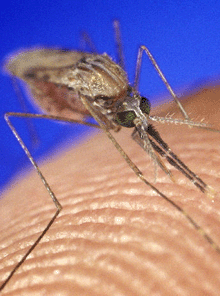Research Matters
|
Search Research Matters
|
October 20, 2008 Scientists Analyze Genome of Relapsing Malaria ParasiteScientists have deciphered the complete genetic sequence of the parasite Plasmodium vivax, the leading cause of relapsing malaria, and compared it with the genomes of other species of malaria parasites. The findings shed light on distinctive genetic features of P. vivax and may lead to new tools to prevent and treat P. vivax malaria.  Image courtesy of Jim Gathany, CDC.
Four species of Plasmodium parasite cause malaria in humans. Plasmodium falciparum is responsible for most malaria deaths, especially in Africa. P. vivax is the most geographically widespread. More than 2.6 billion people are at risk of developing vivax malaria, with a heavy concentration of cases in Asia and Latin America. Although P. vivax infection is rarely fatal, relapses can occur for up to 3 years, and the chronic disease it causes is debilitating. Symptoms include repeated episodes of high fever followed by headache, chills and profuse sweating. This is often accompanied by vomiting, diarrhea and enlargement of the spleen. Patients treated for the primary blood stage infection but not specifically for dormant disease are at great risk of relapse. One obstacle for researchers has been that P. vivax can’t be grown in the laboratory, making it a relatively neglected area of study. “With the publication of the first genome sequence, we hope to reverse this trend and provide a resource for scientists to pursue studies on this important parasite,” said lead investigator Dr. Jane M. Carlton of New York University’s Langone Medical Center. The sequence of the P. vivax genome, along with a comparison to other malaria parasites, appeared in the October 9, 2008, issue of Nature. The work was funded by NIH’s National Institute of Allergy and Infectious Diseases (NIAID) and National Institute of General Medical Sciences (NIGMS). Although P. vivax resembles the other human malaria parasites, it has novel gene families that encode potential alternative pathways into red blood cells not previously recognized. Importantly, the research team identified some P. vivax genes with similarities to genes in other organisms, such as yeast, that are responsible for dormancy. These genes may allow scientists to study the mechanisms of the parasite’s dormant liver stage and perhaps find ways to disrupt it. “Plasmodium vivax relapse presents serious challenges to scientists and doctors alike,” says NIAID Director Dr. Anthony S. Fauci. “Completion of the P. vivax genome promises to provide new insights into the biology of vivax malaria and new leads for therapies and vaccines.” Related Links:Scientists Analyze Genome of Relapsing Malaria Parasite This page was last updated
October 20, 2008
.
|



